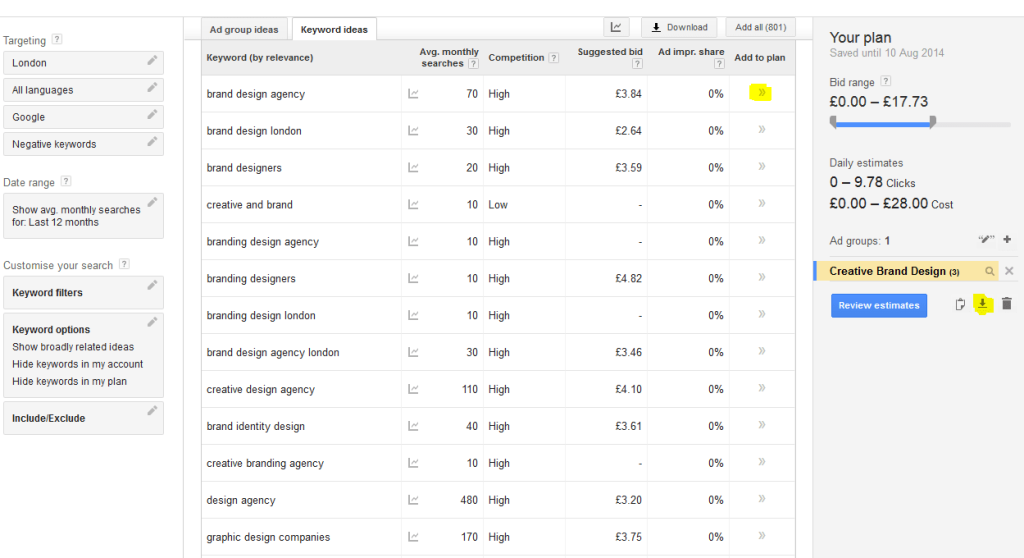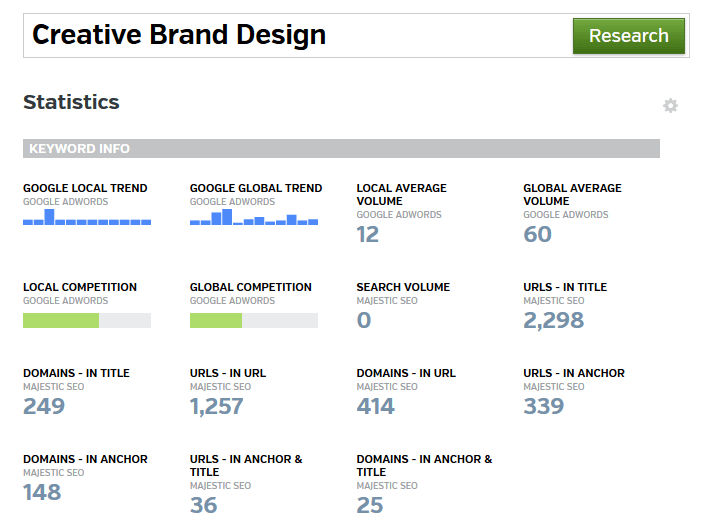Whether you’re considering SEO or running a pay per click campaign, the most important step is the first one: Keyword Research. You want to set yourself up for success, so determining which keywords will be the most effective and successful for you to rank for will take a little bit of research.
How to Find You Keywords
The first step will be searching for a keyword research tool. There are a lot available and you might find many online communities debating which online tool is the best.
Our suggestion would be to use the Google Adwords keyword planner tool, to initially get some keyword ideas and generate a shortlist of potential keywords.
Although this Google platform was created to assist customers in utilising Adwords, the Keyword Planner Tool can be an extremely useful function when doing your keyword research. Basically, you plug in a webpage or a list of keywords and it will spit back a list of relevant keyword ideas and all the relevant data attached with them.
So head over to adwords (https://adwords.google.com), create an account if you don’t already have one and go to Tools then keyword planner.
Once on the keyword planner click “Search for new keywords and ad group ideas”, enter some suggestions or a landing page (maybe a competitors at this stage). Make sure you have selected your correct target location, the default is United States (which is no good for you if you target market is London), then click Get Ideas.
This will generate lots of suggestions in various “ad group ideas”. At this stage we’re simply looking for some decent keywords for ourselves, so ad groups are not all that relevant…click the “keyword ideas” tab.
There you go! A massive list of all relevant keywords for your suggested keywords/landing page. Scroll through clicking the “add to plan” arrow for any that you feel are relevant ( arrow highlighted in yellow):

Once you’re done adding all your relevant keywords to your “plan”, download your plan in an excel doc ( download button highlighted in yellow).
Now you should have a long list of keywords that are relevant to what you want to rank for. Have a quick look over the data in the excel doc with the aim to produce a shortlist ( 10-20 keywords, depending on your goal):
The Data
Search Volume – The higher this number, the more people who are searching for this particular keyword, which means better.
Competition – The Google competition score is their measure of how competitive that keyword is. It is shown as a score between 0 and 1: eg. 0.14. The lower the score the better.
Suggested Bid – This value will serve to give you a good understanding of what type of competitors you are going to be going head to head with. The more people that are trying to compete for each keyword, the higher the suggested bid value will be. For example, in the very competitive industry of Injury Claims, you might see a suggested bid of £20-25 per click! Crazy right? This would be a good indication to cut those keywords from your shortlist (unless you have a seriously large marketing budget).
You should look at these figures collectively and not individually in order to have a good grasp on the whole picture. Ideally, a keyword with a high search volume with a low competition and suggested bid. Most importantl, keywords that are relevant to your website.
Further Analysis of keyword data
For this you’ll probably want a slightly more sophisticated keyword research tool, again there are a lot out there.
Here at Creative Brand Design we use one called Raventools ( https://raventools.com/ ). This research tool actually compiles data from a variety of sources to give you a fairly comprehensive general overview of a keyword (or webpage).

Gathering this type of data is the perfect way to start your keyword research. It will give you the basis to begin more in depth research.
This gives us an overview of each keyword we’ve shortlisted, from here we can make an executive decision on the potential performance for that keyword.
Most of these figures analyse search volume and competition, most being pretty self-explanatory.
Taking a look at the Google search volume trends is an extremely useful way to identify when the demand for your specific keyword is at a high or a low. For instance; in our industry we identified that the search volume for keywords related to SEO approx doubles in the Months of December, January and February – a really surprising statistic for us!
A few other ways to perform keyword research:
Competitor Research
This is a great way to see what everyone else in your position is doing. Understanding your ‘enemy’ is a key strategy.
Analyse their website and determine which keywords they have chosen to rank for. You can find this by looking at the Title Tag for their homepage, the Meta Description, the Meta keyword tag and the H1 tags. ( You can use Google to see this)

Take a look right in the source code of the competitor’s website for the Meta keyword tags by right clicking and selecting, ‘View Source’. You will see something that looks like:
“<meta name=”keywords” content=” This is where their keywords will be ” />
These Meta keywords tags will not always be included on every page and Google actually now ignores these tags in their algorithm due to systematic SEO abuse in the past.
The Header 1 tag can also be found by right clicking and selecting, ‘View Source’. It will look like this:
<h1> Keyword the page is about </h1>
H1 tags are also something you may not find on every page. They will only usually be on pages that have been well optimised, hence the generalisation you will find the keyword listed in the heading. Standard practice.
Use the information you find here to add to or adapt your keyword short list.
Calculating the KEI and KOI
What is KEI and KOI?
KEI – Keyword Effectiveness Index: a composite score of the competitiveness and popularity
KOI – Keyword Opportunity Index:
This is taking the shortlist you have created in the first few steps to the next level using a little data analysis.
KEI is calculated using the formula:
KEI = V 2 ÷ C
In this equation V represents the number of searches for the given specific keyword. C represents the total number of websites which contain the exact keyword phrase. The higher the KEI the better (ie. More popular keyword with less competition).
KOI is calculated using the formula:
KOI = V 2 ÷ D
In this equation V represents the number of searches for the given specific keyword. D represents the competing web pages found using the tool Allinanchor. Similarly, the higher the KOI the better, meaning more potential.
If you’re not really feeling like reverting back to maths lessons there are a lot of tools which will do that calculations for you. Such as: https://www.4d-media.ca/online-kei-calculator/
Which Keywords Are Best?
By this point you have looked through all the data sources available to compile your keyword information. This mass of statistics and data may seem a little overwhelming at first, but you should have collected a great shortlist.
How can you tell which keywords are good for your website and which ones are not?
Simply put: run a Google Adword campaign.
Take your keyword shortlist and plug it straight into a Adwords PPC campaign ( make sure you see our article Measuring PPC Success first: https://www.cbwebsitedesign.co.uk/seo/measuring-ppc-success/ ) . Connect your analytics with Adwords, set up goals and run the campaign. Sit back and wait for the results to start flowing in. Analyse all the data to determine the keywords successes, failures and the onsite engagement level for each activity. This is a great way to judge your keywords before you invest a large capital into any large budget PPC or organic SEO campaign.
Why is Keyword Research Important?
There are actually many reasons why keyword research is extremely important. Not to list them all save for the main one; if you don’t effectively plan and utilise the most effective keywords for your website and the market you are attempting to target, the entire foundation of your SEO or PPC campaign will be completely flawed before you have even started.
Take the keyword 1 and keyword 2 example:
Keyword 1 might give you a goal success rate of 20% and a value of £80, keyword 2 a goal success of 15% and a value of £55. Therefore keyword 1 is the obvious choice over keyword 2. Your keyword research will tell you this.
If you went ahead with your keyword 2 campaign after not doing any keyword research, you will have set yourself up to never achieve the full potential. Keyword 2 will always be less efficient than keyword 1 simply because of its lower conversion rate and value. In economic terms its simple weighing up of opportunity cost (the benefit forgone of the next best alternative).Keyword research is, in fact, the most important aspect of SEO.
Conclusion
Before you start any new campaign, think about keyword research. Spend a little bit of time researching your shortlist and crunching data. The adverse long terms effect on choosing inefficient keywords can be astronomical. Be smart and start with the right steps to push the potential of your success to the highest degree.
